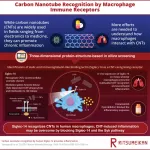(Press-News.org) BOSTON – Scientists have long predicted that global climate change could fuel an increase in the frequency and severity of natural disasters including hurricanes, heatwaves and cold snaps, droughts and floods and wildfires. In a paper published in the Journal of Climate Change and Health, members of the Beth Israel Deaconess Medical Center (BIDMC) Fellowship in Disaster Medicine estimated that climate change-related natural disasters have increased since 1980 and have already cost the United States more than $2 trillion in recovery costs. Their analysis also suggests that as atmospheric carbon dioxide levels and the global temperature continue to rise, the frequency and severity of disasters will increase, with recovery costs potentially rising exponentially.
“The United States spends a staggering amount on costs secondary to natural disasters,” said senior author Gregory Ciottone, MD, director of the Disaster Medicine Fellowship at BIDMC. “Carbon dioxide levels and temperatures have increased over the past four decades and are strongly positively correlated with the number and cost of billion-dollar disasters, suggesting the annual number of events will continue to increase along with their economic burden. Measures are needed to mitigate those costs.”
To assess the relationship between rising carbon dioxide levels, temperatures and the number of disasters costing a billion dollars or more in the United States, Ciottone and colleagues analyzed data between 1980-2021 from the National Center for Environmental Information (NCEI). Since 1980, NCEI has kept track of disasters such as hurricanes, droughts, floods, winter storms, cold waves and crop freeze events that exceeded a billion dollars in damages. Costs factored in include physical damage to infrastructure, agricultural losses and business interruption.
The team found that the increases in atmospheric carbon dioxide levels and temperature — tightly linked to each other — were associated with increasing numbers of events per year, as well as fatalities. After adjusting dollar values for inflation, their analysis showed that more frequent and more severe disasters are incurring rising costs.
Among their findings:
As the global temperature rose by almost one degree Celsius, there was a steady increase in the frequency of billion-dollar disasters, from just 3 in 1980 to 22 in 2020.
From 1980-1989, there were 3 billion-dollar events per year and 297 deaths per year, costing a total of $19.5 billion. By 2010-2019, the rise in carbon dioxide levels and temperature were linked with 13 annual events, 523 annual deaths, and $89.2 billion in recovery costs, a fourfold increase.
In the last five years, the rise in carbon dioxide levels was associated with 18 events per year, 911 deaths per year, and $153 billion in recovery costs, almost double the amount spent in the previous decade.
“Taken together, these data points suggest an exponential relationship between carbon dioxide levels, temperature and disasters that could translate into increased disaster frequency, severity, unpredictability, healthcare costs, healthcare utilization and deaths in the United States,” said Ciottone, who is also president of the World Association for Disaster and Emergency Medicine and an associate professor of emergency medicine at Harvard Medical School. “To truly mitigate the economic impacts of disasters, policies combatting CO2 emissions and therefore temperature change are required. Disaster Risk Reduction strategies can also lead to cost reductions and save human lives.”
Disaster Risk Reduction emphasizes taking steps to reduce the harm and impact caused by disasters on society. Such measures include adopting the latest building codes and retrofitting critical disaster infrastructure lifelines such as telecommunications, roads, power and water infrastructure. A study in 2005 estimated that for every one dollar invested in disaster risk mitigation efforts saved four dollars in post-disaster rebuilding efforts. New data in 2019 showed one dollar spent on mitigation measures could save 11 dollars post-disaster.
“Framing disasters in this economic light can bring more attention and motivation for change to alter policymakers’ decisions,” said corresponding author Vijai Bhola, MD, a graduate of the Disaster Medicine Fellowship at BIDMC, who notes the current analysis captures just a fraction of the costs incurred by climate change. “These costs represent a combination of immediate and longer-term restoration estimates. What they do not reflect, however, are factors such as destruction of natural resources or loss of life, and therefore these numbers significantly underestimate the true cost of climate-related disasters.”
Co-authors included Attila Hertelendy, Alexander Hart and Syafwan Bin Adnan of the Disaster Medicine Fellowship at BIDMC.
This work was conducted with support from Harvard Catalyst/ The Harvard Clinical and Translational Science Center, the National Center for Advancing Translational Sciences, the National Institutes of Health (UL1TR002541) and Harvard University.
The authors declare that they have no known competing financial interests or personal relationships that could have appeared to influence the work reported in this paper. Hertelendy serves as an editor on the Journal of Climate Change and Health.
About Beth Israel Deaconess Medical Center
Beth Israel Deaconess Medical Center is a leading academic medical center, where extraordinary care is supported by high-quality education and research. BIDMC is a teaching affiliate of Harvard Medical School, and consistently ranks as a national leader among independent hospitals in National Institutes of Health funding. BIDMC is the official hospital of the Boston Red Sox.
Beth Israel Deaconess Medical Center is a part of Beth Israel Lahey Health, a health care system that brings together academic medical centers and teaching hospitals, community and specialty hospitals, more than 4,800 physicians and 36,000 employees in a shared mission to expand access to great care and advance the science and practice of medicine through groundbreaking research and education.
# # #
END
Washington, April 6, 2023—The American Educational Research Association (AERA) has announced the winners of its 2023 awards for excellence in education research.
“We are honored to present this year’s awards to an excellent and deserving group of scholars,” said AERA Executive Director Felice J. Levine. “Their contributions to education research, across all career stages and fields, have made and continue to make a difference in the lives of students and educators.”
AERA will ...
When you walk through a forest, you are surrounded by carbon. Every branch and every leaf, every inch of trunk and every tendril of unseen root contains carbon pulled from the atmosphere through photosynthesis. And as long as it stays stored away inside that forest, it’s not contributing to the rising concentrations of carbon dioxide that cause climate change. So it’s only natural that we might want to use forests’ carbon-storage superpower as a potential climate solution in addition to reducing human greenhouse gas emissions.
But climate change itself might compromise how permanently forests are able to store carbon and keep it out of the air, according to a new paper by ...
AURORA, Colo. (April 6, 2023) – Understanding how cancer develops is critical for designing effective, personalized cancer therapies. Researchers have known for years that cancer begins with mutations in certain types of genes. One of these types of cancer genes are so-called “tumor suppressors.” When functioning normally, tumor suppressor genes can stop malignant cells from undergoing uncontrolled cell proliferation and initiate a process of cell elimination called apoptosis, a form of cell death. Mutations in tumor suppressor genes can cause these genes to lose their functionality, eventually contributing to the development of cancer.
In a recent ...
ITHACA, N.Y. – To manage atmospheric carbon dioxide and convert the gas into a useful product, Cornell University scientists have dusted off an archaic – now 120 years old – electrochemical equation.
The calculation – named the Cottrell equation for chemist Frederick Gardner Cottrell, who developed it in 1903 – can help today’s researchers understand the several reactions that carbon dioxide can take when electrochemistry is applied and pulsed on a lab bench.
The electrochemical reduction of carbon dioxide presents an opportunity to transform the gas from an environmental liability to a feedstock ...
Currently, 12.5% of U.S. adults smoke cigarettes. At the same time, more than one-third of U.S. adults seek health information online, making social media a potentially powerful platform for anti-tobacco campaigns. However, limited research has been done on effective social media strategies for anti-smoking campaigns.
An interprofessional Mason research team led by Associate Professors in the Department of Health Administration and Policy Hong Xue and Gilbert Gimm found that the most popular anti-tobacco campaigns on Facebook were informational and discussed the negative effects of smoking. ...
East Hanover, NJ – April 6, 2023 – Ada Chen, PhD, at Kessler Foundation was awarded a two-year grant for $187,000 from the Craig H. Neilsen Foundation to improve the return-to-work rate and employment outcomes for inpatients with spinal cord injury (SCI). Her study is titled “Employment after SCI: Stakeholder Perceptions and Experiences of Vocational Resource Facilitation.”
“The Vocational Resource Facilitation (VRF) pilot project – developed as an early intervention – has already shown promising outcomes in improving return-to-work rates,” said Dr. Chen. “Further investigation of VRF participant and stakeholder experiences and perceptions ...
FOR IMMEDIATE RELEASE
A new drug, a monoclonal antibody known as enoblituzumab, is safe in men with aggressive prostate cancer and may induce clinical activity against cancer throughout the body, according to a phase 2 study led by investigators at the Johns Hopkins Kimmel Cancer Center and its Bloomberg~Kimmel Institute for Cancer Immunotherapy. If confirmed in additional studies, enoblituzumab could become the first promising antibody-based immunotherapy agent against prostate cancer.
In a clinical trial, 32 men with high-risk or very high-risk prostate cancers who were scheduled ...
Carbon nanotubes (CNTs) have become a mainstay of the field of nanotechnology. Finding innovative applications across materials science, electronics, and medicine, CNTs have garnered a lot of attention from researchers in recent years. However, the International Chemical Secretariat (ChemSec) has moved to flag CNTs on the “Substitute It Now!” database of chemicals likely to be restricted for use. In fact, due to their persistence in nature and potential toxicity to humans, ChemSec has proposed that adequate assessments of CNTs' risk to human health are urgently needed.
Following their entry into the body, and much like asbestos, CNTs are targeted by the immune system and preferentially ...
A key enzyme in sugar metabolism is inactivated particularly easily and efficiently by oxidative stress. Scientists at the German Cancer Research Center (Deutsches Krebsforschungszentrum, DKFZ) have now shown that with this oxidation, cells switch to an alternative sugar breakdown pathway and can thus escape oxidative stress. Cancer cells in particular benefit from this mechanism, which can also protect them from therapy-related damage.
One of the central enzymes in sugar breakdown, GAPDH (glyceraldehyde-3-phosphate dehydrogenase), ...
Think about how frustrating it is to try to fit a gift into a box that is too small. Sometimes you just need a bigger box.
Building a bigger box
Nanocages are tiny artificial containers that can be used to deliver therapeutics to a target destination in the body. But some drug molecules are like gifts that are too big for a standard-sized nanocage ‘box’. Now, in an article published today in Nature Synthesis, researchers from the University of Cambridge describe how they have built a super-sized nanocage that could be used to deliver larger drug cargoes. They have built a bigger box.
Simple building blocks
Rational control over the self-assembly of these types of cages generally ...


